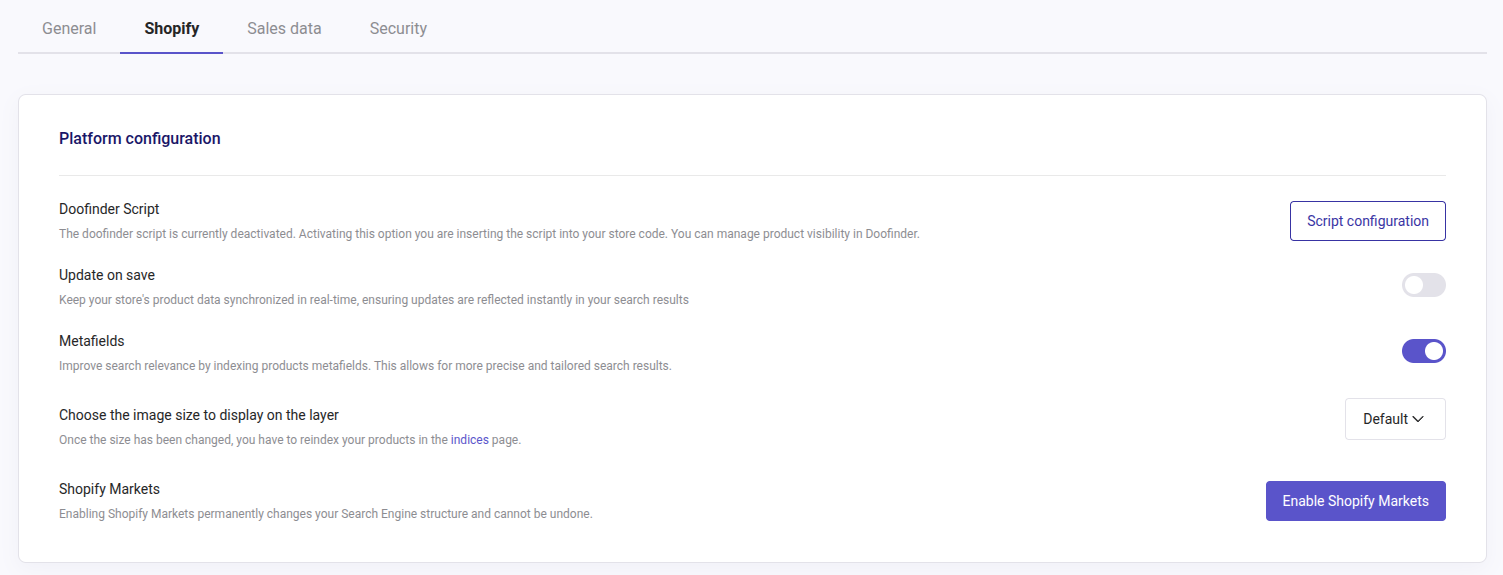Shopify Markets is a powerful cross-border management tool designed to help businesses expand globally. From a single store, you can identify, set up, launch, optimize, and manage your international markets.
For a detailed explanation of how Shopify Markets works, check out this blog.
How Doofinder Integrates with Shopify Markets
When integrating with Doofinder, for each active language, a Search Engine is created. If a store contains English, Spanish, and French, Doofinder will create 3 separated Search Engines.
During the indexation process, Doofinder reads all markets configuration in the Shopify Admin Panel to be able to manage specific prices, catalog visibility and currencies displayed for each product and customer.
| Shopify Setup | Doofinder Setup |
|---|---|
| 1 Store with 3 Languages (EN, ES, FR) | Doofinder creates 3 Search Engines (1 per language) |
| 1 Store with 1 Language (EN) but 1 Market with multiple regions (UK, ES, FR) | Doofinder creates 1 Search Engine (EN) and prices differ by region using price_name |
| 1 Store with 1 Language (EN) but 1 Market with multiple companies | Doofinder creates 1 Search Engine (EN) and prices differ by company using price_name |
Learn by Example - Markets and Search Engines
- You create a Europe Market with UK, ES, FR regions and EN language.
- Doofinder creates 1 Search Engine (EN).
- A UK customer visits the store.
- Shopify determines for a UK customer that the UK market applies to this customer (the UK Market being more specific than the Europe Market).
- Shopify sends Doofinder the UK catalog prices and currency.
- Doofinder displays those prices using the UK
price_name.
Shopify always applies the most specific market to a customer. Therefore, Doofinder’s price_name attribute will always display that price.
Managing Product Visibility Across Markets - Shopify Markets
Product Visibility in the layer depends on the catalog of the Market applied to a customer and its configuration in Shopify Markets:
-
If a Market does not have a specific catalog, it inherits the catalog from the parent market.
-
Excluded products on a catalog will appear under the
not_published_inattribute with the regions where that exclusion is applied using theprice_nameattribute.
How to Activate Shopify Markets in Doofinder
For Already Existing Stores in Doofinder
Transitioning to Shopify Markets will replace existing Search Engines in Doofinder. Past analytics data will no longer be accessible.
If you are not using Shopify Markets and already had a Store created in Doofinder:
- Go to your Doofinder Admin Panel > Configuration > General Settings.
- In the top bar of the panel, click on the Shopify tab to access the Platform Configuration section.
-
Scroll down to Shopify Markets and click “Enable Shopify Markets”.
If you were already using Shopify Markets at a regional level and also want compatibility with Markets B2B, you may need to give Doofinder additional permissions for
< read_companies >.

Alternatively, install Doofinder again. In this case, the Search Engines will be created anew and indexed accordingly.
For New Stores in Doofinder
If you are using Shopify Markets and creating Search Engines in Doofinder for the first time, a Search Engine will be automatically created for each language, and prices will be indexed taking into consideration each market configuration.

